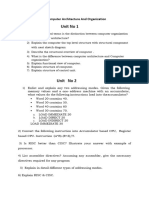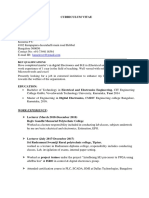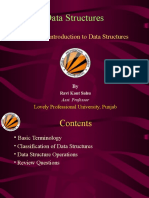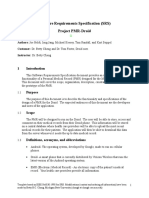Module 1 (Unit - 2)
Module 1 (Unit - 2)
Uploaded by
Kusuma P ChandrashekharCopyright:
Available Formats
Module 1 (Unit - 2)
Module 1 (Unit - 2)
Uploaded by
Kusuma P ChandrashekharOriginal Title
Copyright
Available Formats
Share this document
Did you find this document useful?
Is this content inappropriate?
Copyright:
Available Formats
Module 1 (Unit - 2)
Module 1 (Unit - 2)
Uploaded by
Kusuma P ChandrashekharCopyright:
Available Formats
MODULE - 1
1. Give two definition for real time systems. classify them based on time constraints.
Explain them with an example and appropriate equations.
explain different types of real time systems . compare hard and soft real time systems 8M
2. Explain the different types of programs in system design.
i. Multi tasking
ii. Real time 6M
3. Explain in detail, the generalized computer control system showing hardware and software
interface. 10M
4. Explain computer control system showing communication tasks with block diagram 8M
5. Differentiate between multitasking and sequential program. 4M
6. Explain with block diagram sampled feedback control system 8M
7. Describe the elements of a computer control system 8M
8. Write 4 responsibilities of a control engineer. 4M
9. Explain the following :
1) Clock based tasks
2) Event base tasks
3) Interactive system 6M
10. Differentiate real time systems and non -real time systems 2M
11. Explain the classification of RTS based on synchronization between external process and
internal tasks of computer. (CLOCK BASED, EVENT, INTERACTIVE )
6M
12. Explain the classification of programming 8M
13. Explain periodic and aperiodic tasks with examples
MODULE 1(UNIT – 2)
1. List out the activities and objectives carried out by the computer in computer control
application. 6M
2. What is DDC ? Explain in brief the different possible techniques used for it. 10M
3. Write a note on hierarchical system with neat sketch 5/4M
4.Explain distributed system with neat diagram, list the major advantages of this approach 10M
4.Explain distributed system with neat diagram, and mention the features of HCI 10M
5.explain DDC. Discuss PID cotroller algorithm 6M
6.explain continuous processing and laboratory system. 8M
7. Draw and explain direct digital control (DDC) 8M
8. what are the advantages of DDC over anolog control. 4M
9.with an example, explain sequence control in field application 10M
10. Explain supervisory control, with an example 5M
11. explain sequence control for a single chemical reactor vessel,with neat sketch 6M
12.compare batch processing and continuous processing with examples 6M
13.explain the following
i. Supervisory control system
ii. Batch process and continuous process
iii. PID control algorithm
14. What do you mean by inferential control ? draw general structure of inferential control
configuration.
Explain inferential control by taking the example of binary distillation column 8M
MODULE 2
1. What is the necessity of using specialized processor in RTS? Explain the differen forms of
parallel computer architectures.
2. Explain the basic interrupt input mechanism with diagram and flow chart.
3. Explain multilevel interrupts.
4. Explain the ISO seven layer model with neat diagram.
5. Define interrupt. Explain the working of daisy-chain interrupt.
6. Explain single-chip computer with neat diagram
7. Explain function of ISR with the help of flow chart.
8. Explain SIMD and MISD with neat diagram
9. Mention features of specialized processors
10. Describe hardware vectored interrupts.
11. Explain process related interface with suitable examples
12. Write an explanatory note on pulse input and output interfaces
13. Explain digital signal interference ,with a neat diagram
14. Explain with a neat diagram analog input and analog output system
15. Explain various methods of DMA.
16. Explain asynchronous and synchronous transmission techniques.
You might also like
- Beginners Guide To Successful CardsharingDocument8 pagesBeginners Guide To Successful CardsharingAndriatsitohaina RabenaivoNo ratings yet
- Addreslist Game PUPG+FF+MLDocument10 pagesAddreslist Game PUPG+FF+MLM Munib ArisandyNo ratings yet
- Me7 Tuner Wizzard - XLSM - 0Document81 pagesMe7 Tuner Wizzard - XLSM - 0lytoselputoamoNo ratings yet
- RTS Question BankDocument2 pagesRTS Question Bankharshithkn27No ratings yet
- Question Bank CompleteDocument5 pagesQuestion Bank CompleteSaurabh SenNo ratings yet
- 1st IA QB OSDocument3 pages1st IA QB OSKartik KumarNo ratings yet
- All Question PaperDocument6 pagesAll Question PaperRishi Kesan DNo ratings yet
- Practise - ESDocument3 pagesPractise - ESankitasahasaha008No ratings yet
- RTS 1st Internals Oct 2020Document1 pageRTS 1st Internals Oct 2020manju0071No ratings yet
- Question BankDocument2 pagesQuestion BankYouTube YouTube vancedNo ratings yet
- As Es 2023-2Document6 pagesAs Es 2023-2Sneha GolakiyaNo ratings yet
- Assignments On Embedded SystemsDocument1 pageAssignments On Embedded Systemslaxmipoudel1116No ratings yet
- Cs6303 - Computer Architecture Question Bank Unit-I Overview & Instructions Part - A (2 MARKS)Document4 pagesCs6303 - Computer Architecture Question Bank Unit-I Overview & Instructions Part - A (2 MARKS)muza bashaNo ratings yet
- CO Imp QuestionsDocument1 pageCO Imp Questionsrakeshkolupuru9No ratings yet
- Question Bank Os - Ia1Document2 pagesQuestion Bank Os - Ia1KAVYA SHREENo ratings yet
- Suggestive QuestionDocument4 pagesSuggestive Questiondebojitpaul926No ratings yet
- Practical QuestionsDocument3 pagesPractical QuestionsorlamylekhanNo ratings yet
- Questions: Embedded System Design: 1.1 Introduction, History, Application AreasDocument7 pagesQuestions: Embedded System Design: 1.1 Introduction, History, Application AreasXXXNo ratings yet
- Os-Paper-Imp-Q Sem 4Document2 pagesOs-Paper-Imp-Q Sem 4WednesdayNo ratings yet
- OsDocument1 pageOssaiprashanthnv338No ratings yet
- QB-COADocument4 pagesQB-COAashishlewateNo ratings yet
- OS Module 1 Imp QstsDocument1 pageOS Module 1 Imp QstsAnupNo ratings yet
- EI2402 LogicandDistributedControlSystemquestionbankDocument5 pagesEI2402 LogicandDistributedControlSystemquestionbankTamizhNambiNo ratings yet
- EI2402-Logic and Distributed Control System QB PDFDocument5 pagesEI2402-Logic and Distributed Control System QB PDFGlan DevadhasNo ratings yet
- Coa QBDocument6 pagesCoa QBsourabha prasadNo ratings yet
- Assignment Questions For OsDocument1 pageAssignment Questions For OsVarun. B. C0% (1)
- Question BankDocument10 pagesQuestion BankShelke AbhishekNo ratings yet
- Global Academy of Technology: Question BankDocument6 pagesGlobal Academy of Technology: Question Banksourabha prasadNo ratings yet
- Elective III-410252C-Embedded and Real Time Operating Systems Question BankDocument2 pagesElective III-410252C-Embedded and Real Time Operating Systems Question Bankvishal borate100% (1)
- Unit 1: Introduction To Operating System Structure: ComputingDocument2 pagesUnit 1: Introduction To Operating System Structure: ComputingShobha KumarNo ratings yet
- Question Bank (MES)Document1 pageQuestion Bank (MES)Srinivas DNo ratings yet
- Bachelor of Computer Application (BCA) : Second SemesterDocument3 pagesBachelor of Computer Application (BCA) : Second SemesterNabin Bahadur DhamiNo ratings yet
- ACA Assignment 1Document2 pagesACA Assignment 1yawarNo ratings yet
- RTS Assignment-1Document1 pageRTS Assignment-1Kusuma P ChandrashekharNo ratings yet
- May 2018Document25 pagesMay 2018RAAJ KISHOR R HNo ratings yet
- Module 1 QBDocument1 pageModule 1 QBadku23eceNo ratings yet
- QNP Vlsi CappDocument2 pagesQNP Vlsi CappParvathy S ParvathyNo ratings yet
- RtesDocument6 pagesRteschaitanyaNo ratings yet
- Ios Important QuestionsDocument1 pageIos Important Questionssachin mNo ratings yet
- CSE-MECS Super-Imp-Tie-22Document2 pagesCSE-MECS Super-Imp-Tie-22Shan MpNo ratings yet
- Computer Organzation and Architecture Question BankDocument10 pagesComputer Organzation and Architecture Question Bankmichael100% (2)
- IES Important Model QuestionsDocument6 pagesIES Important Model Questionsdivakarmass444No ratings yet
- EE8691-Embedded SystemsDocument10 pagesEE8691-Embedded SystemspranavNo ratings yet
- IT1353 Embedded SystemDocument6 pagesIT1353 Embedded SystemReeshma ApNo ratings yet
- IA Question bankDocument5 pagesIA Question bankNeel PatelNo ratings yet
- Cao Question BankDocument4 pagesCao Question Banknashikexplore1No ratings yet
- RTS Super-Imp-Tie-23Document2 pagesRTS Super-Imp-Tie-23CHETHAN SHETTIGARNo ratings yet
- Operating SystemsDocument12 pagesOperating SystemsAnita Sofia KeyserNo ratings yet
- Coa QBDocument6 pagesCoa QBmramanareddy198415tsNo ratings yet
- CAD/CAM Important QuestionsDocument3 pagesCAD/CAM Important Questionsivs yeswanthNo ratings yet
- DSDocument9 pagesDSJayant KodamNo ratings yet
- MCA Model QP 2016Document12 pagesMCA Model QP 2016SUNEESHKUMAR PNo ratings yet
- OSY 7 Years Assignment (1, 2 & 3)Document3 pagesOSY 7 Years Assignment (1, 2 & 3)verycutestbabyNo ratings yet
- Design of Mechatronics System QBDocument14 pagesDesign of Mechatronics System QBChandni DayakarNo ratings yet
- 1, Microcontroller Course Out StandardDocument3 pages1, Microcontroller Course Out Standardcurtisandrea242No ratings yet
- B.E. (2015 Pattern) Question BankDocument102 pagesB.E. (2015 Pattern) Question BankAnanya SwaminathanNo ratings yet
- Question Bank For Unit Test #1Document2 pagesQuestion Bank For Unit Test #1Nikita PatilNo ratings yet
- Important TopicsDocument2 pagesImportant Topicspriyasunu3No ratings yet
- Computer Architecture & OrganizationDocument4 pagesComputer Architecture & OrganizationUma MaheswariNo ratings yet
- Embedded System IT2354 Question Bank Anna University R2008Document6 pagesEmbedded System IT2354 Question Bank Anna University R2008Mukesh BollineniNo ratings yet
- Programming Multicore and Many-core Computing SystemsFrom EverandProgramming Multicore and Many-core Computing SystemsSabri PllanaNo ratings yet
- Multivariable Predictive Control: Applications in IndustryFrom EverandMultivariable Predictive Control: Applications in IndustryNo ratings yet
- RTS - Assignment 1Document20 pagesRTS - Assignment 1Kusuma P ChandrashekharNo ratings yet
- Kusuma - Lecture PDFDocument2 pagesKusuma - Lecture PDFKusuma P ChandrashekharNo ratings yet
- Keal Time Sstems: Seme5TerDocument21 pagesKeal Time Sstems: Seme5TerKusuma P ChandrashekharNo ratings yet
- RTS QP 1 PDFDocument1 pageRTS QP 1 PDFKusuma P ChandrashekharNo ratings yet
- VTU Question Papers PDFDocument11 pagesVTU Question Papers PDFKusuma P ChandrashekharNo ratings yet
- Rajiv Gandhi Institute of TechnologyDocument1 pageRajiv Gandhi Institute of TechnologyKusuma P ChandrashekharNo ratings yet
- RTS Assignment-1Document1 pageRTS Assignment-1Kusuma P ChandrashekharNo ratings yet
- Rajiv Gandhi Institute of Technology: B.E - 18EC43Document1 pageRajiv Gandhi Institute of Technology: B.E - 18EC43Kusuma P ChandrashekharNo ratings yet
- Real-Time Systems: June 2012Document81 pagesReal-Time Systems: June 2012Kusuma P ChandrashekharNo ratings yet
- Basic Structure of ComputersDocument16 pagesBasic Structure of ComputersKusuma P ChandrashekharNo ratings yet
- Chapter1 AcaDocument26 pagesChapter1 AcaKusuma P ChandrashekharNo ratings yet
- RRU3804 Introduction and Hardware InstallationDocument75 pagesRRU3804 Introduction and Hardware Installationkarolos1976No ratings yet
- Mobility Driven Network Slicing: An Enabler of On Demand Mobility Management For 5GDocument12 pagesMobility Driven Network Slicing: An Enabler of On Demand Mobility Management For 5GgirishryenniNo ratings yet
- Conceptual FrameworkDocument2 pagesConceptual FrameworkJed PequeñaNo ratings yet
- Sumi Proj Copyprojectdoc (Repaired)Document13 pagesSumi Proj Copyprojectdoc (Repaired)lucky jNo ratings yet
- Lecture 1: Introduction To Data StructuresDocument12 pagesLecture 1: Introduction To Data Structuresdeepak kumarNo ratings yet
- Letter To Government - TemplateDocument1 pageLetter To Government - TemplateJeffrey ReyesNo ratings yet
- IPM TONER Copier Products Price List - July 2020Document39 pagesIPM TONER Copier Products Price List - July 2020Flo xhe90No ratings yet
- Toad 11.5 For Oracle - Beginners GuideDocument86 pagesToad 11.5 For Oracle - Beginners Guidecosmos_adi100% (1)
- CH 9-Laplace TransformDocument117 pagesCH 9-Laplace Transformpoetanonymous11No ratings yet
- Icenter Ex APPDocument40 pagesIcenter Ex APPMuh Ikram50% (2)
- Sales and Accounting Monitoring SystemDocument51 pagesSales and Accounting Monitoring SystemMatt Christian AustriaNo ratings yet
- Computerised Layout PlanningDocument39 pagesComputerised Layout PlanningVarinder SinghNo ratings yet
- Manual HitachiDocument187 pagesManual HitachiFridaNo ratings yet
- 08 09 Exploit Development 102Document137 pages08 09 Exploit Development 102SonyaNo ratings yet
- DK 50 EKOM Manual de Servicio enDocument34 pagesDK 50 EKOM Manual de Servicio enalex obregonNo ratings yet
- ICCAD 2021 Call For PapersDocument3 pagesICCAD 2021 Call For PapersdewufhweuihNo ratings yet
- IAT-I Question Paper With Solution of 15EC741 Multimedia Communication Sep-2019-Pappa M, Dr.K.P.SharmilaDocument18 pagesIAT-I Question Paper With Solution of 15EC741 Multimedia Communication Sep-2019-Pappa M, Dr.K.P.SharmilaBoban MathewsNo ratings yet
- Chapter 15 - SPR24Document83 pagesChapter 15 - SPR24cuongdaomanh26082003No ratings yet
- HDF5 Users GuideDocument342 pagesHDF5 Users GuideHugo Van RuyskensveldeNo ratings yet
- U2 Rational Functions Test Q3Document4 pagesU2 Rational Functions Test Q3Farhan HabibzaiNo ratings yet
- Software Requirements Specification (SRS) Project PMR-DroidDocument20 pagesSoftware Requirements Specification (SRS) Project PMR-Droidinni_imtiaz5382No ratings yet
- Activity 2Document4 pagesActivity 2Christian FrutoNo ratings yet
- D. E. Shaw India - Quality & Test EngineerDocument2 pagesD. E. Shaw India - Quality & Test Engineer4nm20is151No ratings yet
- 1 Bachillerato Semana Del 27 Abril Al 8 de Mayo-1Document8 pages1 Bachillerato Semana Del 27 Abril Al 8 de Mayo-1Mickael Gonzalez FellmannNo ratings yet
- Service Manual Space Station, Space Cover, Space ComDocument140 pagesService Manual Space Station, Space Cover, Space ComMaria Chirinos RodriguezNo ratings yet
- 6th Sem SyllabusDocument13 pages6th Sem SyllabusJeena SubbaNo ratings yet
- Intel Thunderbolt: James Coddington Ed MackowiakDocument28 pagesIntel Thunderbolt: James Coddington Ed MackowiakAkalatronic TunezNo ratings yet



































































































